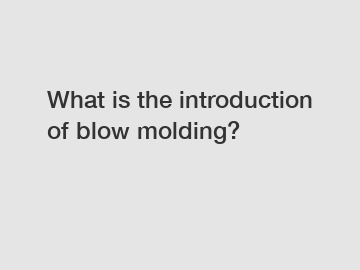What is the introduction of blow molding?
What is Blow Molding?
Blow molding is a versatile manufacturing method that is commonly used in the production of bottles, containers, and other hollow plastic products. The process involves three main types: extrusion blow molding, injection blow molding, and injection stretch blow molding. Each of these techniques has its own advantages and is best suited for specific applications.
Extrusion blow molding is the most commonly used method and involves melting plastic pellets and extruding them into a hollow tube. The tube is then clamped into a mold and inflated with air to create the desired shape. This process is used to make products such as bottles, containers, and automotive components.

Injection blow molding, on the other hand, involves injecting molten plastic into a mold cavity and then blowing air into it to create the final product. This method is commonly used to produce small, intricate parts such as medical devices, pharmaceutical packaging, and drink cups.
Injection stretch blow molding combines injection molding and blow molding techniques to create high-quality, lightweight products with superior strength and durability. This method is often used to produce bottles for beverages, cosmetics, and household products.
The Advantages of Blow Molding.
There are several key advantages to using blow molding as a manufacturing technique. One of the main benefits is the ability to produce complex shapes and designs with a high level of precision. This process allows for the creation of seamless, lightweight products that are both aesthetically pleasing and functional.
Additionally, blow molding is a cost-effective method that can significantly reduce production costs compared to other manufacturing techniques. This process requires minimal tooling and setup time, making it ideal for mass production and quick turnaround times.
Another advantage of blow molding is its ability to produce products with consistent wall thickness and dimensional accuracy. This results in products that are strong, durable, and resistant to impact and puncture.
Furthermore, blow molding is an environmentally friendly manufacturing method that produces minimal waste and can be easily recycled. This process also requires less energy and resources compared to other manufacturing techniques, making it a sustainable option for businesses looking to reduce their carbon footprint.
The Future of Blow Molding.
The future of blow molding is bright, with advancements in technology and materials driving innovation in the industry. New developments in materials science have led to the creation of bio-based plastics that are renewable, biodegradable, and compostable. These eco-friendly materials are increasingly being used in blow molding to create sustainable products that meet the demands of environmentally conscious consumers.
Advances in automation and robotics have also improved the efficiency and productivity of blow molding processes. These developments have enabled manufacturers to increase production speeds, reduce production costs, and improve product quality.
Furthermore, 3D printing technology is being integrated into blow molding processes, allowing for the creation of custom-designed products with intricate shapes and features. This technology is revolutionizing the way products are manufactured and is opening up new possibilities for designers and engineers.
Are you interested in learning more about Auto Feeding EPE Foam Cut Cutting Machine, bubble sheet manufacturing machine, Multi-Layer Film Extrusion Machine? Contact us today to secure an expert consultation!

Comments
0